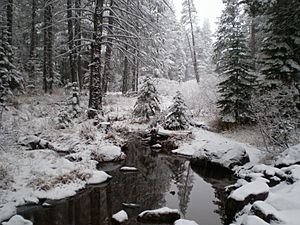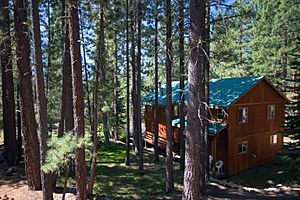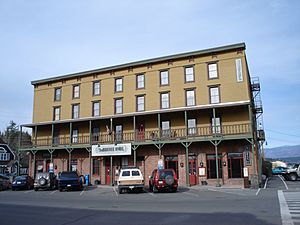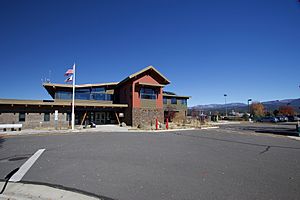Truckee, California facts for kids
Quick facts for kids
Truckee
|
|||
|---|---|---|---|
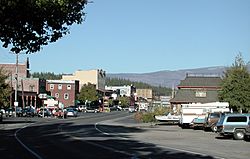
Donner Pass Road
|
|||
|
|||
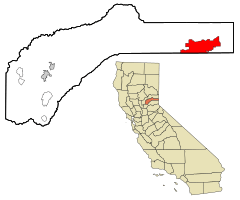
Location in Nevada County in the state of California
|
|||
| Country | United States | ||
| State | California | ||
| County | Nevada | ||
| Incorporated | March 23, 1993 | ||
| Named for | Truckee | ||
| Area | |||
| • Total | 33.66 sq mi (87.19 km2) | ||
| • Land | 32.33 sq mi (83.74 km2) | ||
| • Water | 1.33 sq mi (3.45 km2) 3.96% | ||
| Elevation | 6,152 ft (1,875 m) | ||
| Population
(2020)
|
|||
| • Total | 16,729 | ||
| • Density | 517.6/sq mi (199.84/km2) | ||
| Time zone | UTC−8 (Pacific) | ||
| • Summer (DST) | UTC−7 (PDT) | ||
| ZIP Codes |
96160–96162
|
||
| Area code | 530 | ||
| FIPS code | 06-80588 | ||
| GNIS feature IDs | 2413403 | ||
Truckee is a town in Nevada County, California, United States. It's known for its beautiful mountain setting and rich history. As of 2020, about 16,729 people live in Truckee. The town is located in the Sierra Nevada mountains, close to Donner Lake.
Contents
History of Truckee
How Truckee Got Its Name
Truckee started as a small settlement called Gray's Station in 1863. It was named after Joseph Gray, who ran a roadhouse there. Later, it was called Coburn's Station.
In 1867, the Central Pacific Railroad chose the name "Truckee" for its new station. The town was named after a friendly Paiute chief. His real Paiute name was Tru-ki-zo. When the first Europeans met his tribe, the chief rode towards them yelling, "Tro-kay!" This meant "Everything is all right" in his language. The travelers thought he was saying his name, and so the name "Truckee" stuck. Chief Truckee later helped John C. Frémont as a guide.
The Donner Party Story
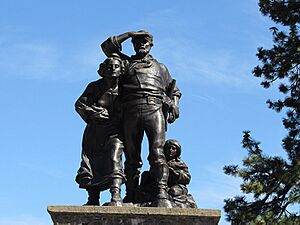
One of the most famous historical events in the Truckee area is the story of the Donner Party. In 1846, a group of settlers from Illinois, known as the Donner Party, faced a terrible challenge. They were trying to travel west to California.
They made several mistakes, like taking shortcuts and having problems crossing the Utah salt flats. An early winter storm trapped them near what is now Donner Lake. This was about 90 miles east of their goal, Sutter's Fort (near Sacramento).

The deep snow and freezing weather made it impossible to move their wagons and supplies over the steep Sierra Nevada mountains. The group had to return to the edge of Donner Lake. Some also stayed at a camp a few miles east at Alder Creek.
During the harsh winter, many travelers suffered greatly from starvation. Some members of the group resorted to eating human flesh to survive. Fifteen people tried to leave on snowshoes to get help, but only seven made it. The others died and were used as food by the survivors.
Help finally arrived when a member of the original party, who had left earlier, sent several rescue groups. Out of 87 original settlers, 48 survived the difficult journey. Today, the Donner Memorial State Park honors these settlers. It is located at the east end of Donner Lake.
Other Historical Events
Truckee grew into a busy railroad town. The Transcontinental Railroad passed right through downtown Truckee. Even today, the Amtrak passenger trains still stop here on their way from Chicago to San Francisco.
In the late 1800s, there was a sad period of discrimination against Chinese people in Truckee. In 1876, some people in town formed a group to try and force Chinese woodcutters to leave the area. They even set fire to cabins where Chinese workers lived, and one man was killed. Later, in 1886, most of the Chinese residents, about 1,400 people, were forced to leave Truckee.
Truckee was also home to one of the nation's first machine-powered ski lifts. This was at the Hilltop Lodge, which is now the Cottonwood Restaurant and Bar. There was also a ski jump built in the early 1900s, designed by Lars Haugen, a famous Olympic ski jumper.
In 1993, Truckee officially became an incorporated town.
Geography and Climate
Truckee covers about 33.7 square miles (87.2 square kilometers). Most of this area is land, but about 1.3 square miles (3.4 square kilometers) is water. This water includes parts of Donner Lake and the Truckee River.
Weather in Truckee
Truckee has a unique climate because it's high up in the Sierra Nevada mountains. Winters are cold with lots of snow. Summers are warm and dry, but sometimes have strong thunderstorms.
It snows a lot in Truckee! Winter storms can bring several feet of snow in just a day. The town gets about 206.6 inches (5.2 meters) of snow each year on average. This makes it one of the snowiest cities in the United States.
The warmest month is July, with average high temperatures around 83.8°F (28.8°C). January is the coldest month, with average low temperatures around 15.9°F (-8.9°C). It can freeze any month of the year. The highest temperature ever recorded was 101°F (38°C) in August 1915. The lowest was -28°F (-33°C) in February 1962.
| Climate data for Truckee, California (Truckee Ranger Station), 1991–2020 normals, extremes 1904–2009 | |||||||||||||
|---|---|---|---|---|---|---|---|---|---|---|---|---|---|
| Month | Jan | Feb | Mar | Apr | May | Jun | Jul | Aug | Sep | Oct | Nov | Dec | Year |
| Record high °F (°C) | 64 (18) |
68 (20) |
73 (23) |
83 (28) |
92 (33) |
94 (34) |
100 (38) |
101 (38) |
95 (35) |
87 (31) |
82 (28) |
66 (19) |
101 (38) |
| Mean maximum °F (°C) | 52.9 (11.6) |
55.0 (12.8) |
60.6 (15.9) |
68.9 (20.5) |
78.8 (26.0) |
86.8 (30.4) |
91.9 (33.3) |
91.1 (32.8) |
86.2 (30.1) |
77.7 (25.4) |
65.9 (18.8) |
55.0 (12.8) |
94.1 (34.5) |
| Mean daily maximum °F (°C) | 41.8 (5.4) |
44.5 (6.9) |
49.6 (9.8) |
54.8 (12.7) |
64.3 (17.9) |
74.8 (23.8) |
83.8 (28.8) |
83.8 (28.8) |
76.2 (24.6) |
64.6 (18.1) |
50.9 (10.5) |
40.5 (4.7) |
60.8 (16.0) |
| Daily mean °F (°C) | 28.8 (−1.8) |
29.9 (−1.2) |
35.4 (1.9) |
40.0 (4.4) |
47.8 (8.8) |
55.3 (12.9) |
62.6 (17.0) |
62.1 (16.7) |
55.2 (12.9) |
46.0 (7.8) |
36.0 (2.2) |
27.8 (−2.3) |
43.9 (6.6) |
| Mean daily minimum °F (°C) | 15.9 (−8.9) |
17.3 (−8.2) |
21.2 (−6.0) |
25.2 (−3.8) |
31.4 (−0.3) |
35.8 (2.1) |
41.4 (5.2) |
40.3 (4.6) |
34.1 (1.2) |
27.5 (−2.5) |
21.2 (−6.0) |
15.0 (−9.4) |
27.2 (−2.7) |
| Mean minimum °F (°C) | −4.1 (−20.1) |
−1.7 (−18.7) |
4.5 (−15.3) |
14.7 (−9.6) |
22.2 (−5.4) |
27.2 (−2.7) |
31.9 (−0.1) |
31.2 (−0.4) |
25.9 (−3.4) |
18.9 (−7.3) |
7.2 (−13.8) |
−0.9 (−18.3) |
−8.9 (−22.7) |
| Record low °F (°C) | −28 (−33) |
−23 (−31) |
−18 (−28) |
−1 (−18) |
6 (−14) |
18 (−8) |
15 (−9) |
20 (−7) |
16 (−9) |
4 (−16) |
−14 (−26) |
−30 (−34) |
−30 (−34) |
| Average precipitation inches (mm) | 5.68 (144) |
5.09 (129) |
4.46 (113) |
2.13 (54) |
1.49 (38) |
0.57 (14) |
0.26 (6.6) |
0.53 (13) |
0.63 (16) |
1.77 (45) |
2.81 (71) |
5.15 (131) |
30.57 (774.6) |
| Average snowfall inches (cm) | 43.6 (111) |
47.9 (122) |
34.2 (87) |
17.5 (44) |
4.1 (10) |
0.9 (2.3) |
0.0 (0.0) |
0.0 (0.0) |
0.5 (1.3) |
2.8 (7.1) |
14.9 (38) |
44.2 (112) |
210.6 (534.7) |
| Average extreme snow depth inches (cm) | 35 (89) |
42 (110) |
38 (97) |
20 (51) |
4 (10) |
0 (0) |
0 (0) |
0 (0) |
0 (0) |
2 (5.1) |
10 (25) |
25 (64) |
60 (150) |
| Average precipitation days (≥ 0.01 in) | 11.9 | 11.0 | 10.0 | 9.4 | 7.3 | 3.2 | 1.9 | 2.0 | 2.8 | 4.9 | 7.7 | 11.6 | 83.7 |
| Average snowy days (≥ 0.1 in) | 8.7 | 8.1 | 7.2 | 5.1 | 1.6 | 0.3 | 0.0 | 0.0 | 0.2 | 1.2 | 4.2 | 7.8 | 44.4 |
| Source 1: NOAA | |||||||||||||
| Source 2: WRCC (mean maxima and minima 1904–2009) | |||||||||||||
People of Truckee
| Historical population | |||
|---|---|---|---|
| Census | Pop. | %± | |
| 1880 | 1,147 | — | |
| 1890 | 1,350 | 17.7% | |
| 1970 | 1,392 | — | |
| 1980 | 2,389 | 71.6% | |
| 1990 | 3,484 | 45.8% | |
| 2000 | 13,864 | 297.9% | |
| 2010 | 16,180 | 16.7% | |
| 2020 | 16,729 | 3.4% | |
| 2023 (est.) | 17,039 | 5.3% | |
| U.S. Decennial Census | |||
In 2020, the population of Truckee was 16,729 people. Most residents (77.4%) were White. About 18.7% of the population identified as Hispanic or Latino. Other groups included Asian (1.6%), Native American (0.5%), and African American (0.2%).
About 22.2% of Truckee's residents were under 18 years old. The average age of people living in Truckee was 41.9 years.
There were 6,247 households in Truckee. Many of these (59.7%) were families with married couples.
Education in Truckee
The Tahoe-Truckee Unified School District manages schools in Truckee and the nearby Lake Tahoe area. In Truckee itself, there are six schools:
- Two elementary schools
- One elementary-middle school
- One middle school
- Two high schools, including Truckee High School
Getting Around Truckee
Truckee has several ways to get around:
- Train: The California Zephyr train, run by Amtrak, stops daily at Truckee station.
- Bus: A free public bus service connects Truckee station to Lake Tahoe and Incline Village, Nevada.
- Interstate 80: This major highway passes right through Truckee, making it easy to drive to and from the town.
- Airport: The Truckee-Tahoe Airport is available for smaller planes and private flights.
Notable People from Truckee
- Krista Benjamin, a poet and writer
- Stacey Cook, a World Cup alpine ski racer
- Andy Finch, a snowboarder
- Travis Ganong, a World Cup alpine ski racer
- Chas Guldemond, a snowboarder
- Jeremy Jones, a snowboarder
- Daron Rahlves, a former World Skiing champion and Olympian
- Karly Shorr, a snowboarder
- Marco Sullivan, a former World Cup alpine ski racer
See also
 In Spanish: Truckee para niños
In Spanish: Truckee para niños



